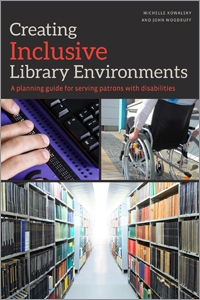Primary tabs
You don't need to be an ALA Member to purchase from the ALA Store, but you'll be asked to create an online account/profile during checkout to proceed. This Web Account is for both Members and non-Members. Note that your ALA Member discount will be applied at the final step of the checkout process.
If you are Tax-Exempt, please verify that your account is currently set up as exempt before placing your order, as our new fulfillment center will need current documentation. Learn how to verify here.
- Description
- Table of Contents
- About the authors
- Reviews
Librarians are continually faced with challenges of how to best meet the needs of patrons with disabilities, whether those patrons have physical or intellectual disabilities, differing learning styles, or even temporary problems which impact their access and may change over time. And because planning considerations range from policies and organizational culture to facilities, technologies, and beyond, librarians need a guide that covers everything: areas that can be addressed quickly and easily as well as those that require long-term strategies. That guide is here. Packed with research-based best practices and handy checklists applicable to all types of libraries, this comprehensive resource
- defines what makes environments barrier-free, whether physical or virtual, and talks about how libraries can develop a user-centered culture;
- includes techniques for writing policies and procedures that are clear, realistic, and flexible;
- provides strategies for setting up facilities, training staff, and maintaining daily operations;
- discusses collaboration and outreach through community partnerships, including ways to connect patrons with nonprofits and disability organizations;
- offers programming and workshop ideas such as open houses, tutorials, and tours of the library;
- delves into assistive technology, website design, making vendor-purchased products accessible, and other information technology issues; and
- shares ideas for library assessment, realigning strategies, and staying current.
This planning guide will enable libraries to create and maintain a truly inclusive environment for all patrons.
Preface
Chapter 1 Introduction to Creating Inclusive Libraries
Chapter 2 Writing Policies and Procedures
Chapter 3 Setting Up Facilities
Chapter 4 Training Library Staff
Chapter 5 Maintaining Daily Operations
Chapter 6 Collaborations and Outreach
Chapter 7 Programming and Workshop Ideas
Chapter 8 Accessible Resources and Technologies
Chapter 9 Developing a User-Centered Culture
Chapter 10 Keeping Up to Date
About the Authors
Index
Michelle Kowalsky
Michelle Kowalsky is a librarian and professor at Rowan University, Glassboro, New Jersey. She teaches and supervises undergraduate learners and graduate students in their research endeavors. Michelle holds an EdD from Pepperdine University and an MLS from Rutgers University, and is a National Board Certified Teacher of Library Media. Her most recent activities have been upgrade of Campbell Library's Digital Learning Center with software and furniture recommended by students with disabilities; development of information literacy instruction and reference services in a variety of subject areas, most recently for business majors; and supervision of dissertation research for doctoral students in the College of Education. Prior to working in academia, she worked as a public librarian, a corporate librarian, and a K−12 school librarian and teacher for over 20 years.
John Woodruff
John Woodruff is Director of the Academic Success Center and Disability Resources at Rowan University, Glassboro, New Jersey. He coordinates campus services for students with disabilities and manages transitions for students entering college. John holds an MS in Health Education from St. Joseph's University and a BS in Business Administration from St. Francis University (Loretto, Pennsylvania). His most recent activities include outreach to faculty and students to increase empathy for the varying needs of students; development of year-round speaker programs, activities, and events to promote understanding on campus and in the local community; and leadership of faculty-led and community-led strategic partnerships for awareness, training, and mentoring. His professional career reflects over 30 years of education, training, administration, and management of employment and training programs for persons with disabilities.
”The book features checklists to support the various topics, as well as examples of programming schedules ... Kowalsky and Woodruff's contribution thoroughly addresses an underrepresented yet worthwhile topic. Demonstrated through their experiences and research, their expertise on the subject makes this work a valuable and credible resource."
— Library Journal
”With this work by Kowalsky and Woodruff as a guide, libraries will be able to achieve the most inclusive environment possible. This will benefit not only those in the enviable position of building from scratch, but also those who must retrofit existing environments ... Recommended for all libraries."
— Journal of Hospital Librarianship
"Concise but complete ... This title has two major strengths: its emphasis on invisible disabilities in addition to visible ones, and its recognition of the needs of library employees with disabilities, along with the needs of patrons. The suggestions provided throughout this book will help make libraries more ergonomic and person-friendly, benefiting everyone, not just those with disabilities."
— Reference & User Services Quarterly
”Kowalsky and Woodruff cover the whole spectrum ... They offer a starter’s kit of possible programs and workshops and cite the need to have a variety of stakeholders involved throughout the processes the library undertakes."
— VOYA



